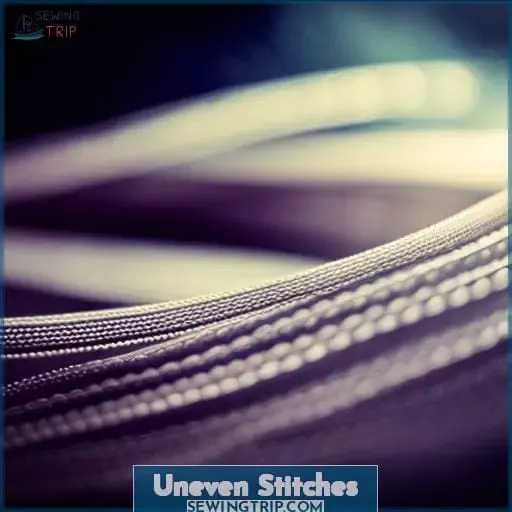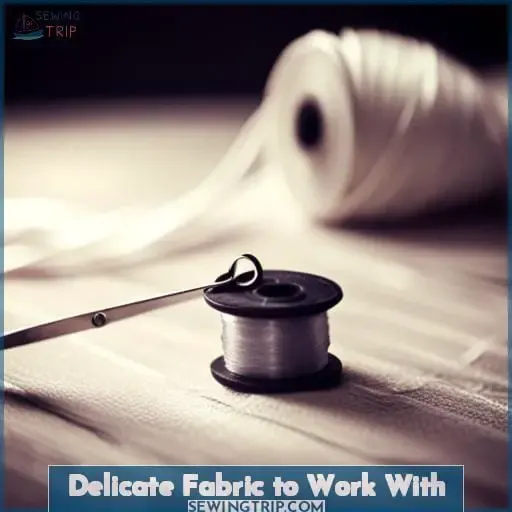This site is supported by our readers. We may earn a commission, at no cost to you, if you purchase through links.
 Ready to tackle the challenges of sewing tulle? With its delicate nature and slippery surface, this lightweight fabric can be a bit tricky to work with. But fear not! In this article, we’ll share expert tips and tricks for achieving a perfect finish when sewing tulle.
Ready to tackle the challenges of sewing tulle? With its delicate nature and slippery surface, this lightweight fabric can be a bit tricky to work with. But fear not! In this article, we’ll share expert tips and tricks for achieving a perfect finish when sewing tulle.
From dealing with uneven stitches to hemming difficulties, we’ve got you covered.
Table Of Contents
Key Takeaways
- Use a short stitch length.
- Use a stabilizer underneath the fabric.
- Lower the presser foot pressure by 10-15 units.
- Use a sharp needle specifically designed for delicate fabrics.
Uneven Stitches
To achieve a perfect finish when sewing tulle, ensure that your stitches are even throughout the fabric. Uneven stitches can detract from the overall appearance of your project and compromise its quality.
To prevent this issue, there are several steps you can take.
First, use a short stitch length to maintain consistency in your stitching.
Additionally, using a stabilizer underneath the tulle fabric can help stabilize it and prevent shifting during sewing.
Lowering the presser foot pressure by 10-15 units will also contribute to more even stitching on delicate fabrics like tulle.
Furthermore, using a sharp needle specifically designed for delicate fabrics is crucial for achieving precise results without damaging or tearing the material.
Lastly, adjusting tension settings appropriately ensures that your stitches remain uniform throughout the entire project.
Delicate Fabric to Work With
When working with tulle, you’ll find that it’s a delicate fabric that requires careful handling to achieve the perfect finish.
Tulle frays easily and tears easily, so it’s important to take precautions while working with this fabric.
Additionally, tulle can be slippery and difficult to baste due to its lightweight nature.
Static electricity can also be an issue when sewing tulle, causing the fabric to stick together or cling onto other surfaces.
Overall, tulle presents unique challenges in terms of its delicacy and difficulty in manipulation during sewing projects.
By being aware of these factors and using appropriate techniques such as using sharp needles and thread for static build-up prevention, you can successfully work with this delicate fabric for beautiful results.
Difficulty Hemming Tulle
Hemming tulle can be a challenging task due to its delicate nature and lightweight texture. However, there are effective techniques that you can use to overcome this difficulty and achieve a flawless finish.
Here are some tips for hemming tulle:
- Consider leaving the tulle unhemmed: Since tulle doesn’t fray easily, cutting it to the desired length without hemming is often an acceptable option.
- Hand sew with tiny folds and stitches: If you prefer a more finished look, hand sewing is recommended. Make small folds along the edge of the fabric and use tiny stitches to secure them in place.
- Cut accurately: To ensure clean edges for your hemline, cut the tulle fabric carefully while it’s folded using sharp scissors or a rotary cutter.
By following these techniques, you’ll be able to conquer any challenges associated with hemming delicate fabrics like tulle!
Slippery Surface
When working with tulle, you may encounter the challenge of its slippery surface, which can make it difficult to keep in place while sewing. To overcome this issue and achieve a perfect finish, there are several techniques you can employ.
Firstly, consider using a stabilizer underneath the fabric to provide stability and prevent shifting during sewing.
Pins or clips can also be used to hold the layers together securely.
Basting stitches are another useful method for temporarily holding the tulle in place before final stitching.
Additionally, utilizing water-soluble stabilizer won’t only stabilize but also create an easy-to-sew edge on your tulle project.
Finally, using a walking foot attachment on your sewing machine will help feed the slippery fabric smoothly through without any unwanted stretching or distortion.
Layer Shifting
To prevent layer shifting when sewing tulle, make sure you use clips or safety pins to securely hold the layers together.
Layer shifting can occur due to the slippery nature of tulle fabric, making it challenging to keep the layers in place while sewing.
By using stabilizer underneath the fabric and basting the layers together with long, loose stitches or using fabric clips, you can effectively prevent any unwanted movement during stitching.
Another helpful technique is hand sewing for more control over each stitch and ensuring that there’s no shift in the layers as you sew.
Additionally, taking your time and sewing slowly will allow for greater precision and minimize any potential layer shifts that may occur while working with delicate tulle fabrics.
Shows Imperfections
Now that you have learned about the challenges of layer shifting when sewing tulle, let’s move on to another common issue: shows imperfections.
Tulle is a fabric that tends to highlight any flaws or mistakes made during the sewing process.
- Shows gathers: When gathering tulle, it can be difficult to achieve perfectly even and smooth gathers. Uneven gathering can result in an unattractive appearance.
- Shows puckers: Due to its delicate nature, tulle is prone to puckering along seams and edges if not handled properly during sewing.
- Shows needle holes and zigzag stitches: The fine texture of tulle makes needle holes more visible than on other fabrics, especially if you use larger needles or sew with wide zigzag stitches.
To overcome these challenges and ensure a flawless finish when working with tulle, make sure to adjust your machine settings appropriately for this fabric type and use the correct size needle designed specifically for lightweight materials like tulle.
Difficult to Pin
Pinning tulle can be challenging due to its delicate nature and slippery surface.
The fabric tends to float on the fabric, making it difficult to secure with pins. This poses a problem when trying to gather or attach the tulle to other fabrics.
Additionally, tulle is prone to needle skipping and puckering easily, which can result in uneven gathers and an unprofessional finish.
To overcome these difficulties, there are a few techniques you can employ.
One option is using clips instead of pins to hold the layers of tulle together during sewing.
Another tip is basting the layers with long, loose stitches before final stitching for added stability and control over gathering tension.
Requires a Sharp Needle
To achieve a perfect finish when sewing tulle, you’ll need to use a sharp needle.
A sharp needle is essential because it prevents various issues that can arise when working with this delicate fabric.
Here are four reasons why using a sharp needle is crucial:
- Prevents tearing: Tulle is prone to tearing, but using a sharp needle reduces the risk of causing tears while stitching.
- Prevents fraying: A dull or blunt needle can lead to frayed edges on tulle fabric, whereas a sharp one ensures clean and crisp stitches without any fraying.
Tension Issues
When sewing tulle, it’s important to be mindful of tension issues as they can affect the overall quality of your stitches.
To avoid any problems, use stabilizer on the fabric and test it beforehand to ensure the tension is just right.
Lowering the tension on your sewing machine will also help prevent any puckering or distortion in the tulle.
Additionally, using a sharp needle specifically designed for delicate fabrics like tulle will result in cleaner and more precise stitches.
Lastly, opting for a shorter stitch length will provide better control and stability when working with this fragile material.
By following these tips, you’ll master sewing tulle with ease while achieving flawless results every time.
Sensitive to Heat
Be cautious with tulle as it’s sensitive to heat and can easily be damaged.
When exposed to high temperatures, tulle can scorch, melt, or even burn. The delicate nature of this fabric makes it susceptible to shrinking and becoming brittle when subjected to excessive heat.
To avoid damaging your tulle during the sewing process, take extra care when using tools such as an iron or a hot presser foot.
Always use a low heat setting and place a pressing cloth between the iron and the fabric for added protection. It’s crucial not to apply too much pressure while pressing as this could cause irreversible damage.
By being mindful of its sensitivity towards heat, you can ensure that your tulle remains in pristine condition throughout your sewing project.
Frequently Asked Questions (FAQs)
How can I prevent my stitches from becoming uneven when sewing tulle?
To prevent uneven stitches when sewing tulle, use a straight stitch plate and adjust the stitch length to 3-
Lower the presser foot pressure by 10-15, depending on the number of layers.
What are some tips for working with delicate tulle fabric?
When working with delicate tulle fabric, employ gentle techniques to ensure mastery over its ethereal nature.
Use a fine needle for precision and secure layers with pins or safety clips.
Maintain meticulous stitch length to avoid puckering and use tissue paper beneath the fabric when sewing seams for stability.
How can I make hemming tulle easier?
To make hemming tulle easier, use a rolled hem or narrow hem foot.
Alternatively, bind the raw edges with bias tape.
Practice making tiny folds and stitches for hand-sewing hems, or cut the tulle to length and leave it unhemmed for a simpler finish.
What can I do to keep the slippery tulle fabric in place while sewing?
Looking to keep that slippery tulle fabric in place while sewing? Fear not! Simply use a layer of tissue paper or a stabilizer underneath the fabric.
How do I prevent the layers of tulle from shifting and showing imperfections in my sewing?
To prevent shifting and imperfections in your sewing, ensure that you align the layers of tulle carefully before stitching. Use pins or fabric clips to hold them securely in place throughout the sewing process for a flawless result.
Conclusion
Mastering the art of sewing tulle may seem daunting, but with the right techniques, you can achieve a flawless finish. From dealing with uneven stitches to navigating the delicate fabric, these tips will help you overcome any challenges.
Don’t let the slippery surface or shifting layers discourage you – with a sharp needle, proper tension, and careful pinning, you’ll be able to tackle any tulle project like a pro.
So grab your sewing supplies and embrace the beauty of sewing tulle with confidence.
















